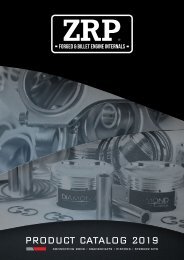ZRP_Catalog_2017
Create successful ePaper yourself
Turn your PDF publications into a flip-book with our unique Google optimized e-Paper software.
4. Check end float (Thrust clearance)<br />
It is advisable to check the thrust clearance at both thrust faces to ensure an accurate measurement.<br />
7. Rod Beam/Cylinder Bore<br />
Interference (IMPORTANT !!!)<br />
( not Required on all Engines )<br />
technical | Installation instructions | Stroker Kit<br />
5. Main Bearings Alignment (IMPORTANT!)<br />
After you have finished with the bearing installation you have achieved proper oil clearance. You have to check the main<br />
bearing alignment. This must be done in a machinery workshop.<br />
6. Crankshaft Installation<br />
A. Clean the Crankshaft very well, after that blow with dry air to clean oil holes thoroughly. Make sure oil holes are flow<br />
free!<br />
B. Inspect all journals to make sure the crank is free of nicks, scratches, and hairline cracks.<br />
C. Spread plenty of oil on all journals before assembly. Do not lubricate the thrust faces of the thrust bearing at this point.<br />
D. Check proper oil clearance and make sure the direction of rod and bearing are corrected. A 0.50mm-0.715mm side<br />
clearance is required<br />
E. Once you have measured all your journals and matched them to their specific bearings, you are ready to lay the crank<br />
in place. Before doing that, however, spread a coat of assembly grease on the bearings to protect the crank.<br />
F. Now position the crank on the block without installing any of the caps, just yet. Install a dial indicator on the nose of the<br />
crank to measure endplay. You should be able to move the crank back and forth by hand. The clearance must be as<br />
suggested by the engine’s manufacturer.<br />
1. Due to the fact that the shape of <strong>ZRP</strong> rods is much wider than OEM, to increase strength, some engines with small<br />
bore and long stroke, may require some milling of the cylinder to provide clearance for the rod to rotate full cycle. This<br />
should be done before the final piston and rod assembly. The recommended clearance is aprox. 1.50mm. Please<br />
check the drawing for guidance. (Required on some Toyota, Ford & Honda)<br />
2. At the bottom end of the stroke cycle the piston skirt touches on the oil squirt. You must rotate the oil squirt approx.<br />
40deg.<br />
technical | Installation instructions | Stroker Kit<br />
G. When you make sure you have the correct amount of endplay, go ahead and install the rear main seal before bolting<br />
on the main cap.<br />
H. The next step is to bolt up and torque all the main cap except for the cap containing the thrust bearing. Make sure you<br />
add oil on the thread of the bolts first. Check your endplay again. If you don’t have enough play, one of the caps is out<br />
of alignment. You can adjust the cap location slightly by tapping it lightly with a dead-blow hammer and then tightening<br />
the bolts back down.<br />
I. Again, if the endplay is correct, you can install the last main cap-this one with the thrust bearing. Tap it into place but<br />
do not torque the cap bolts. Instead, knock the crank lightly, either forward or back, to align the thrust faces of the two<br />
bearing shells. Now tighten the bolts to the proper torque specs.<br />
J Once you have reached this point, most probably the end play has tightened up a bit. You can use a screwdriver<br />
placed between one of the main caps and a counterweight to help you move the crank. Be careful and do not use<br />
excessive force. If there isn’t enough endplay, you may need to reduce the thickness of the thrust face of the thrust<br />
bearing slightly. This can usually get you a thousandth or so. Lightly rub both faces of both halves of the thrust bearing<br />
on super-fine sandpaper that is being lubricated by a constant stream of fluid in your cleaning tank. It’s also a good<br />
idea to use a surface block (or even a pane of glass) underneath the sandpaper to make sure you are sanding on an<br />
even plane. If the endplay is too much, you must use oversized thrust washers.<br />
■ We “strongly” recommend that you balance the crank and flywheel together.<br />
■ All 4340 cranks are nitrited with plasma gas. DO NOT polish journal in any circumstances.<br />
28 29





